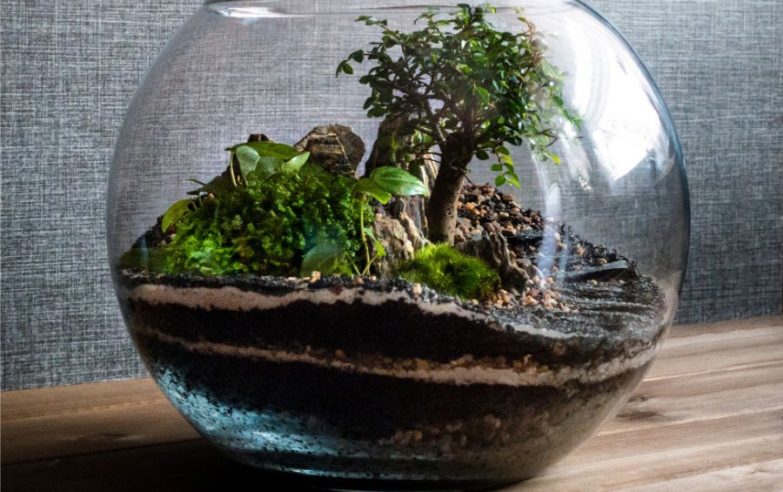Terrariums are a beautiful way to display some of your favorite small houseplants and succulents. In fact, they are like a mini-garden showcase. There are all kinds of ways you can build your terrarium, but you need to start with the right foundation of soil layers to keep your terrarium and your plants healthy. Keep reading to understand learn all you need to know about terrarium soil layers.
Terrarium Soil Layers
To build a successful terrarium, use the following soil layers;
- Drainage Layer – This layer drains and stores excess moisture, reducing the negative impact of growing plants in a container without drainage holes.
- Moss Layer – This layer absorbs excess moisture and is a barrier between the soil and drainage layers.
- Charcoal layer – This layer helps absorb any toxins that might impact the health of your plants or odors which might build up in the terrarium.
- Soil Layer – This is the base which will house your plants. Choosing appropriate soil is crucial for the health of your plants.
- Decorative Soil Layer – I like to add one or more layers of decorative material such as sand, decorative stones or shells between the soil. This gives your terrarium great aesthetic appeal.
- Plant Layer – These are the plants you house in your terrarium. Suitable plants differ depending on whether you are making an open or closed terrarium.
- Ornamental Layer – This layer adds to the decorative appeal of your terrarium.
While not all these layers are essential, they all have a role to play in creating an attractive terrarium that helps your plants to thrive. A drainage layer, soil layer and plant layer are essential. You can choose whether to use the others depending on your preference and the type of terrarium you are building.
Why Worry About Terrarium Soil Layers?
Building a terrarium is like building a house. You need a good foundation, good drainage, and the right conditions for your plants to grow.
Most plants need soil that provides support and delivers oxygen, water and nutrients to the roots. Terrariums are not be ideal places for plants to grow without careful management of drainage and soil layers.
Read more about how terrariums work in this article.
By carefully constructing the environment for your plants, you can create a terrarium that not only looks fantastic, but provides an ideal place for your plants to thrive.
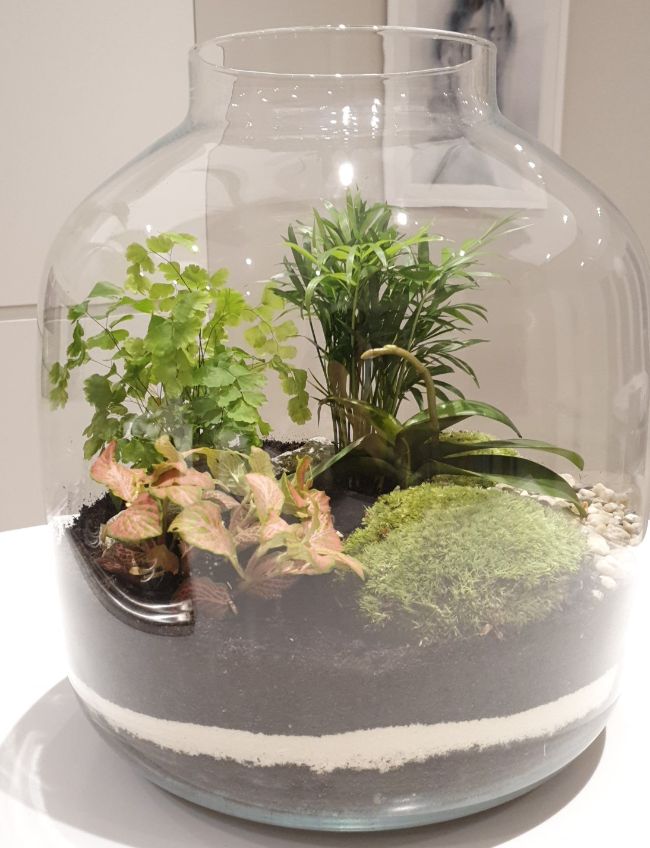
Open And Closed Terrariums
One of the first choices you’ll make when building your terrarium is whether you want an open terrarium or a closed terrarium. A closed terrarium has a lid on it, which allows moisture to build up on the inside. These are great for tropical plants which need higher humidity and moist but not soggy soil. Read more about the history of the closed terrarium.
On the other hand, an open terrarium is better for succulents and cacti because it allows the moisture to evaporate. Succulents, cacti, and even air plants will be happier in an open terrarium and risk rotting in a closed terrarium.
The type of plants you wish to grow in your terrarium will help you decide whether you want an open terrarium or a closed terrarium.
Choose A Container For Your Terrarium
You’ll need a glass container to start your terrarium, and other than that, the choice is yours. You can upcycle a used cookie jar, mason jar, pitcher, or anything that strikes your fancy. If you are going to build a succulent terrarium, then you won’t be needing a lid for your container.
However, if you choose a tropical terrarium, you may want to find a container that has some kind of a lid on it to increase humidity and retain moisture. Once you have your container picked out, make sure it is clean and dry, and then you can start to add the layers.
Terrarium Soil Layers
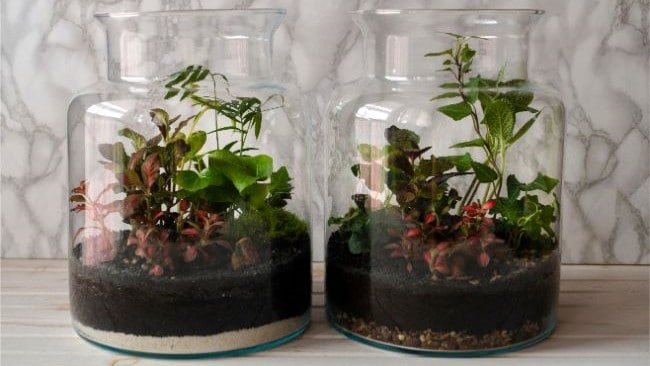
Let’s discuss each layer in turn, starting at the bottom of your terrarium.
Drainage Layer
This layer is essential to safely store excess water at the bottom of the terrarium without it covering the roots, risking root rot. See my article about growing plants in pots without holes for more information. The drainage layer is normally the very bottom layer, although some people prefer to add charcoal, or a decorative layer at the very bottom.
Depending on the size of your terrarium, you’ll place one to two inches of drainage material in the bottom. Don’t skimp here, this layer will allow excess water to drain away from your plants so they don’t sit in water and end up with rotted roots.
Pea gravel is a commonly used type of drainage layer however, you could also use something like small river rocks, colored aquarium gravel, or interesting small rocks that you’ve collected. Decorative stones, sea glass or marbles are also good options.
Another idea to use for the drainage layer is LECA, or Light Expanded Clay Aggregate. These small pebbles are made out of clay and are all natural. After the pebbles are formed from clay, they are fired in a kiln to make them porous and to kill off any pathogens.
These clay pebbles will allow for plenty of drainage in your terrarium without adding a lot of weight, like gravel could do. LECA is pH neutral and will give lots of room for your plants to put down roots. Your layer of LECA could also act as a mini-aquaphor, to store water, which will reduce the need to water your terrarium.
Moss Layer
If you just put in some soil on the top of your drainage layer, the soil can often start to infiltrate the drainage layer over time and get lost in the bottom of the terrarium. If this happens, you could get mold and rot and your terrarium may fail.
In order to prevent this, put a layer of dried moss or sphagnum moss on top of your drainage layer. This will prevent the soil from washing through and also absorb some of the excess moisture.
The moss layer will add a pretty color and texture to the middle layers of your terrarium. Make sure it is thick enough to keep the soil from washing through into the drainage layer.
Charcoal Layer
This is an optional layer, but I feel it is very important for the health and life of your terrarium. The charcoal layer acts as a filter to remove toxins and prevent odors from developing in your terrarium.
I think this layer works best above the moss layer, but some people just add it to the very bottom of the terrarium.
You can use horticultural charcoal or activated charcoal for this purpose. Some people have even used BBQ charcoal in the bottom of their terrariums. Your terrarium can still function without this layer, but you’ll need to be more careful about maintaining optimum conditions.
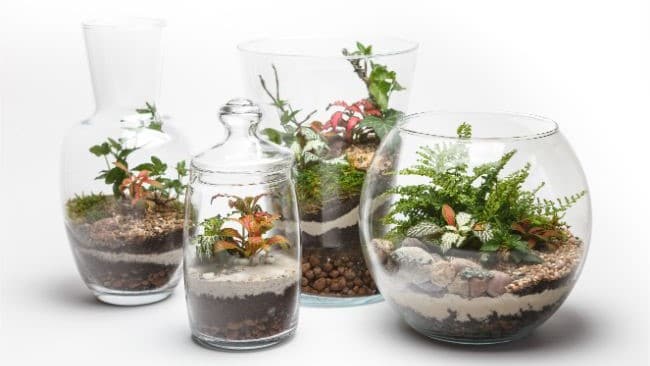
Soil Layer
The soil layer is the place where your plants will grow. The layer of soil serves as an anchor for the roots, as well as provides the nutrients that your plants will need to grow.
You will want to keep in mind what type of terrarium you are building and choose the type of soil based upon the type of plants you are going to plant in your terrarium. There are several options for the soil layer.
- Potting Soil – The easiest, cheapest soil for your terrarium is regular houseplant potting soil. This is a common choice due to its availability and cost and works well for tropical plants.
- African Violet Soil – The Cornell University Extension recommends using African Violet soil for your terrarium. African Violet soil is a very lightweight soil that will keep the plants moist but not soggy.
- DIY Soil – If you choose, you could create your own soil mix using peat moss, vermiculite or perlite, and sterilized soil. This will encourage good drainage and prevent or slow the growth of bacteria or mold in your terrarium.
- Cactus and Succulent Soil – You may need to use a soil that is geared towards succulents and cacti if that is the type of terrarium you are building. This soil will drain much more quickly than other types.
Decorative Soil Layers
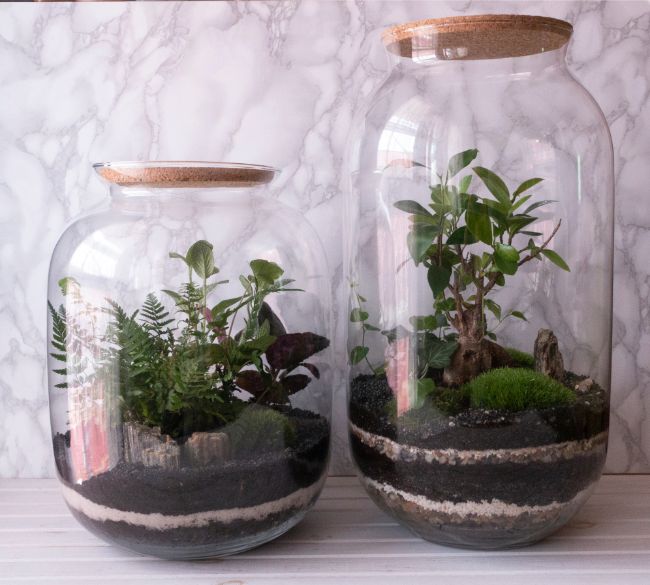
Once you’ve chosen what to use for the essential layers, you can add a little creativity by adding decorative soil layers. Generally the thickest layer in the base of a terrarium is the soil layer, and I like to divide this up with decorative sand or stones. This makes the outside of the terrarium look so much more interesting and appealing.
Any inert, decorative components could be used for this layer, such as colored pebbles, glass beads, small sea shells etc.
Plant Layer
Of course, choosing your plants is one of the most enjoyable parts of building the terrarium. Smaller plants are better choices for small terrariums, since they won’t crowd each other out as they grow.
You do need to stick to one type of plant, such as all tropical plants or all succulent plants or cacti because they have different requirements for moisture.
Succulent terrariums need to be drier, and will need an open top and less moisture, while tropical terrariums can have closed tops, providing more humid, moist conditions.
Good Plants For Closed Terrariums
- Friendship Plants
- Small Peperomias
- Baby Tears
- Spiderwort
- African Violets
- Chamedora Palms
- Fittonia
- Adiantum Ferns
- Cushion Moss
- Phalaenopsis Orchids
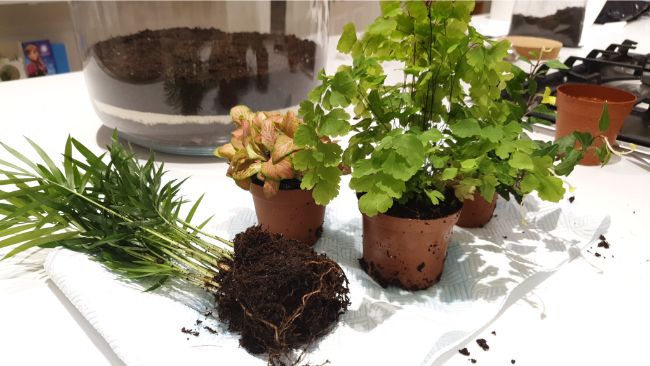
Good Plants For Open Terrariums
- Pincushion cactus
- Hens and Chicks
- Zebra Haworthia
- String of Pearls
- Paddle Plant
Ornamental Layer
The ornamental layer is where you get to add your own pizazz to your terrarium. This layer could be an extra layer of moss or something unique like colored aquarium gravel. If you would rather, you could even use a layer or layers of decorative sand (colored or not). These items will protect the roots of the plants, help the roots stay anchored into the soil, and keep moisture in where it is needed most.
You can also add decorative items to this layer to show off your own personal style.
You might consider using all-natural items such as sea shells, or pretty rocks, or something else entirely such as small sculptures, decorative signs, little people, or anything you can imagine that won’t be damaged by the dirt and moisture content of your terrarium. Use your imagination and get as creative as you like!
How To Make Your Layers Look More Decorative
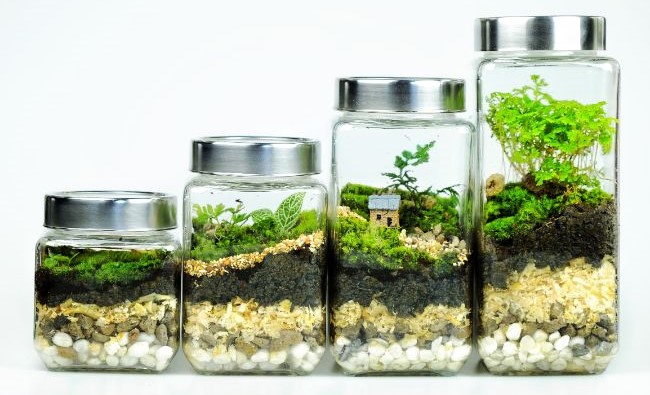
As you build your terrarium, you’ll notice what a beautiful contrast of textures go into your terrarium soil layers. You can use this to your advantage to make your terrarium more interesting.
Make sure your layers are thick enough to see the contrast between them. You can also shape the layers to create a flow within them, for example, making them higher on one side and lower on the other.
You could use several layers of different colored gravel or sand to create stand out patterns, and even match the colors of the gravel and sand to the colors of any flowers growing inside. Be creative and have fun creating your own terrarium.

